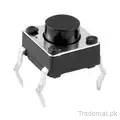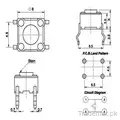Shipping Costs are based on the:
- Product weight
- Shipment weight and volume
Shipment Mode:
- By Air
- By Sea
- By Road
- JazzCash
- Easypaisa
- Bank Transfer
- Cash on delivery
- Visa and MasterCard
- Best price
- 24/7 Support
- Secure Shipping
- Authentic Supplier
- Official Distributor
- 100% Original Products
- Official Brand Warranty
- Different payment methods
Description
Switches don't require any fancy equations to evaluate. All they do is select between an open circuit and a short circuit. Simple. But how could we live without buttons and switches!? What good is a blinky circuit with no user input? Or a deadly robot with no kill switch? What would our world be without with big red buttons you should?never, ever press.
What is a Switch?
A switch is a component which controls the open-ness or closed-ness of an electric circuit. They allow control over current flow in a circuit (without having to actually get in there and manually cut or splice the wires). Switches are critical components in any circuit which requires user interaction or control.
A switch can only exist in one of two states: open or closed. In the'off"state, a switch looks like an open gap in the circuit. This, in effect, looks like an?open circuit, preventing current from flowing.
In the"on"state, a switch acts just like a piece of perfectly-conducting wire. A short. This?closes the circuit, turning the system ?on? and allowing current to flow unimpeded through the rest of the system.
A circuit diagram with an LED, resistor, and a switch. When the switch is closed, current flows and the LED can illuminate. Otherwise no current flows, and the LED receives no power.
There are tons and tons of switches out there: toggle, rotary, DIP, push-button, rocker, membrane, ? the list just goes on and on. Each of those switch types has a set of unique characteristics to differentiate it from others. Characteristics like what action flips the switch, or how many circuits the switch can control. Next up, we?ll go over some of the more basic switch characteristics.
Defining Characteristics
Actuation Method
In order to change from one state to another, a switch must be?actuated. That is, some sort of physical action must be performed to ?flip? the switch?s state. The actuation-method of a switch is one of its more defining characteristics.
Some examples of switch types.?Push button,?rocker,?slide, and?magnetic.
Switch actuation can come from pushing, sliding, rocking, rotating, throwing, pulling, key-turning, heating, magnetizing, kicking, snapping, licking, any physical interaction which can cause the mechanical linkages inside the switch to come into, or go out of, contact.
Switch Applications
On/Off Control
Among the most obvious of switch applications is simple on and off control. The type of control you perform every time you walk into a dark room. An on/off switch can be implemented by simply sticking an SPST?switch in series?with a power-line. Usually the on/off switch will be maintained, like a toggle or slide switch, but momentary on/off switches can have their purpose.
On this Breadboard Power Supply, an SPDT switch is used to turn the circuit on and off. (A second SPDT switch is used to select the adjustable voltage regulator?s output value by adjusting a?voltage divider.)
When implementing such a switch, keep in mind that all the current your project consumes is going to run through that switch. Ideally a switch is a perfect conductor, but realistically it's got a small amount of resistance between the two contacts. Because of that resistance, all switches are rated for a?maximum amount of current?they can withstand. Exceed a switch?s maximum current rating, and you can expect melted plastic and magic smoke.
For example, this SPDT slide switch is great for controlling current flow in small projects (like?Simons?or?Metronomes), but don't try using it to control beefy motor controllers, or strings of 100 LEDs. For that, consider using something like a?4A toggle switch?or a?6A lamp switch.
Features
Reviews
No reviews found






